The ask price, also known as the offer price, is the lowest price a seller is willing to accept for an asset, such as a stock, bond, or commodity. It’s essentially the price at which a potential buyer can purchase a particular asset. The ask price is always higher than the bid price, which is the highest price a buyer is willing to pay for the same asset.
Bid Price vs Ask Price
While the ask price is the lowest price at which a seller is willing to sell, the bid price is the highest price a buyer is willing to pay for the same security. When looking at financial quotes, you’ll typically see both the bid and ask prices listed.
Spread
The difference between the bid price and the ask price is called the spread. A small spread is an indication of a liquid market, while a larger spread indicates a less liquid market. The spread can be an important factor for traders, as it represents the cost of entering or exiting a position in the security.
Understanding Ask Size
Ask size, also known as “offer size,” refers to the number of shares or units of a security that a seller is willing to sell at the specified ask price. It represents the quantity of a particular security available for purchase at the ask price. Ask size is an important aspect of market depth, as it provides valuable information about the supply side of the market.
Why Ask Size Matters
Ask size matters to traders and investors for several reasons:
- Liquidity: A larger ask size indicates higher liquidity, which means that traders can buy or sell a security more easily without affecting its price. A higher liquidity often leads to tighter bid-ask spreads, which can result in lower transaction costs for traders.
- Price Impact: A smaller ask size can lead to significant price movements if there’s a large buy order. In such cases, the buy order may consume the entire ask size and push the ask price higher, potentially causing a price spike.
- Market Sentiment: Analyzing the ask size can help traders gauge market sentiment. For example, a large ask size at a specific price level might indicate that there’s strong selling pressure or resistance at that price, making it difficult for the security’s price to rise further.
How to Use Ask Size in Trading
Traders can use ask size in combination with bid size and other market data to make more informed decisions when trading securities:
- Identify Support and Resistance Levels: By monitoring the ask size along with bid size, traders can identify potential support and resistance levels in the market. A large ask size at a specific price may indicate strong selling pressure, which can act as a resistance level.
- Assess Market Depth: A higher ask size typically indicates a more liquid market, which is beneficial for traders who want to enter or exit positions with minimal impact on the security’s price. By assessing market depth, traders can choose securities with greater liquidity to minimize slippage and transaction costs.
- Evaluate Trading Strategies: Understanding the relationship between ask size and price movements can help traders evaluate the effectiveness of their trading strategies. For example, a trader may want to avoid buying a security with a small ask size if they expect significant price volatility.
Example
Suppose you’re looking to buy shares of XYZ company. After looking up the price of the stock you find the following info:
- Bid Price: $50
- Bid Size: 50 shares
- Ask Price: $51
- Ask Size: 100 shares
Looking at the current bid price we see the highest price buyers are willing to pay is $50 per share. We can also see by looking at the bid size that there are buyers willing to purchase a total of 50 shares at that price.
On the other hand, the asking price is currently telling us the lowest prices sellers are willing to accept is $51 a share. The ask size also shows that there are 100 shares available at that price.
As a seller, if you wanted to sell the stock immediately, you’d need to place your order at the current bid. Otherwise, placing the order at a higher price than that would mean waiting for a buyer to increase their price and match your ask.
FAQs
Ask price, also known as offer price, is the lowest price a seller is willing to accept for an asset. It represents the price at which a potential buyer can purchase the asset.
Ask price is influenced by factors such as market conditions, liquidity, and volatility. Sellers set their ask prices based on their expectations of what buyers will be willing to pay and the level of risk they are willing to accept.
Ask price is the minimum price a seller is willing to accept, while bid price is the maximum price a buyer is willing to pay. The difference between the two is called the spread, which can be an indicator of an asset’s liquidity.



